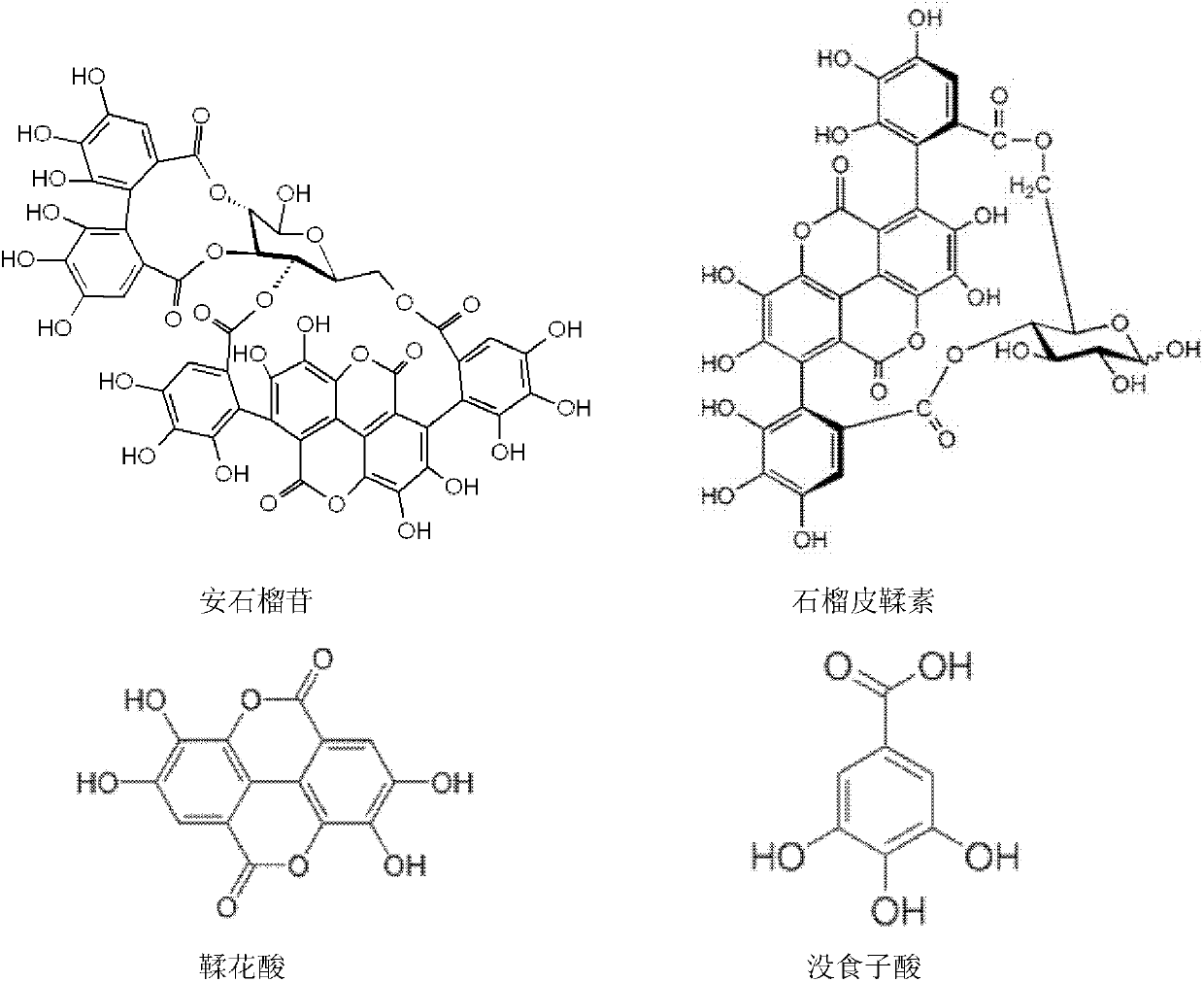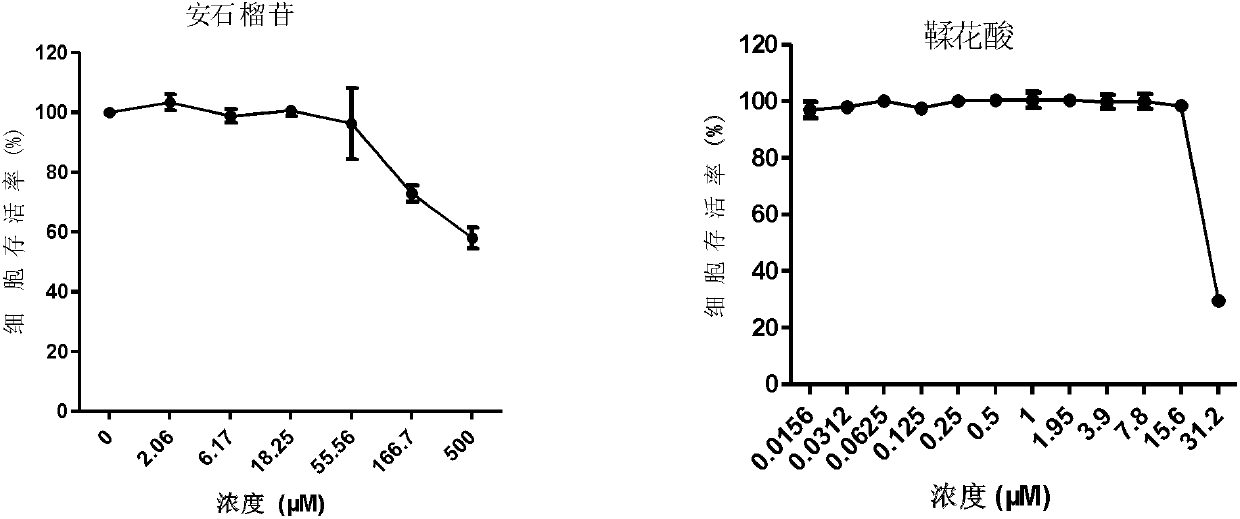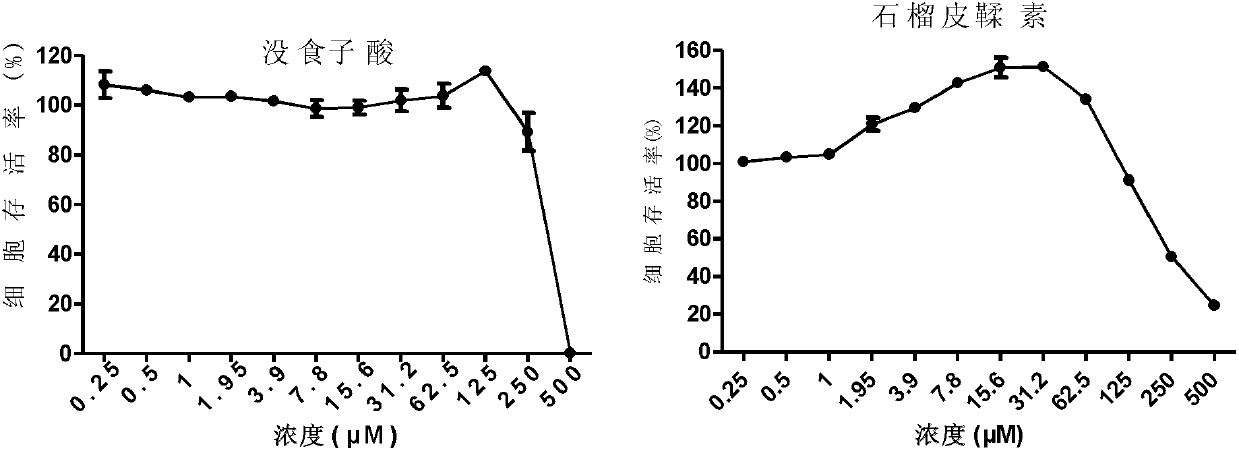Application of pomegranate in preparing medicament for treating or preventing hepatitis B virus infection
A technology of hepatitis B virus and pomegranate extract, applied in the field of medicine, can solve the problems of no application of ellagic acid, etc., and achieve the effects of improving treatment quality and medication compliance, less toxicity, and alleviating treatment pain.
- Summary
- Abstract
- Description
- Claims
- Application Information
AI Technical Summary
Problems solved by technology
Method used
Image
Examples
Embodiment 1
[0044] Example 1: Evaluation of anti-HBV activity of punicalagin, ellagic acid, gallic acid and pomegranate tannin
[0045] 1. Experimental materials
[0046] 1.1 Cells and Drugs
[0047] HepG2.117 cell: Human liver cancer cell line, the HBV genome is integrated in the chromosome, which can support HBV DNA synthesis, protein expression, and produce infectious virus particles. This cell line was donated by Professor Michael Nassal of the University of Freiburg in Germany and researcher Hu Kanghong of the Wuhan Institute of Virology. Picalagin, ellagic acid, and gallic acid were purchased from Sichuan Weikeqi Biotechnology Co., Ltd., and pomegranate tannin was purchased from Shanghai Branch of Wuhan Yitai Technology Co., Ltd.
[0048] 1.2 Reagents
[0049] DMEM medium and fetal bovine serum (FBS) were purchased from GIBCO; HBV surface antigen (S antigen) and e antigen detection kits were purchased from Shanghai Kehua Biotechnology Co., Ltd.; Alamarblue reagent was purchased f...
Embodiment 2
[0058] Example 2: Punicalagin acts directly on cccDNA in the nucleus of liver cells to exert antiviral effect
[0059] 1. Experimental materials
[0060] 1.1 Cells, plasmids and drugs
[0061] HepG2.117 cell: Human liver cancer cell line, the HBV genome is integrated in the chromosome, which can support HBV DNA synthesis, protein expression, and produce infectious virus particles. This cell line was donated by Professor Michael Nassal of the University of Freiburg, Germany, and researcher Hu Kanghong of the Wuhan Institute of Virology. HepG2.2.15 is a human liver cancer cell, donated by Chen Xinwen, a researcher at Wuhan Institute of Virology; punicalagin was purchased from Sichuan Weikeqi Biotechnology Co., Ltd.; Lamivudine was a gift from NIH.
[0062] 1.2 Reagents
[0063] DMEM medium was purchased from GIBCO, Real-time PCR kit was purchased from TOYOBO, and Trizol reagent was purchased from Roche.
[0064] 2. Experimental methods and results
[0065] 2.1 Detection of ...
Embodiment 3
[0074] Example 3: Combination of punicalagin and lamivudine
[0075] 1. Experimental materials
[0076] 1.1 Cells, plasmids and drugs
[0077] HepG2.117 cell: A human liver cancer cell line, the HBV genome is integrated in the chromosome, which can support HBV DNA synthesis, protein expression, and produce infectious virus particles. This cell line was donated by Professor Michael Nassal of the University of Freiburg, Germany, and researcher Hu Kanghong of the Wuhan Institute of Virology. HepG2.2.15 is a human liver cancer cell, donated by Chen Xinwen, a researcher at Wuhan Institute of Virology; punicalagin was purchased from Sichuan Weikeqi Biotechnology Co., Ltd.; Lamivudine was a gift from NIH.
[0078] 1.2 Reagents
[0079] DMEM medium was purchased from GIBCO, and Real-time PCR kit was purchased from TOYOBO. 2. Experimental methods and results
[0080] HepG2.117 and HepG2.2.15 cells were divided into 4×10 4 Cells / well were seeded in 24-well cell culture plates, cult...
PUM
 Login to View More
Login to View More Abstract
Description
Claims
Application Information
 Login to View More
Login to View More - R&D
- Intellectual Property
- Life Sciences
- Materials
- Tech Scout
- Unparalleled Data Quality
- Higher Quality Content
- 60% Fewer Hallucinations
Browse by: Latest US Patents, China's latest patents, Technical Efficacy Thesaurus, Application Domain, Technology Topic, Popular Technical Reports.
© 2025 PatSnap. All rights reserved.Legal|Privacy policy|Modern Slavery Act Transparency Statement|Sitemap|About US| Contact US: help@patsnap.com



